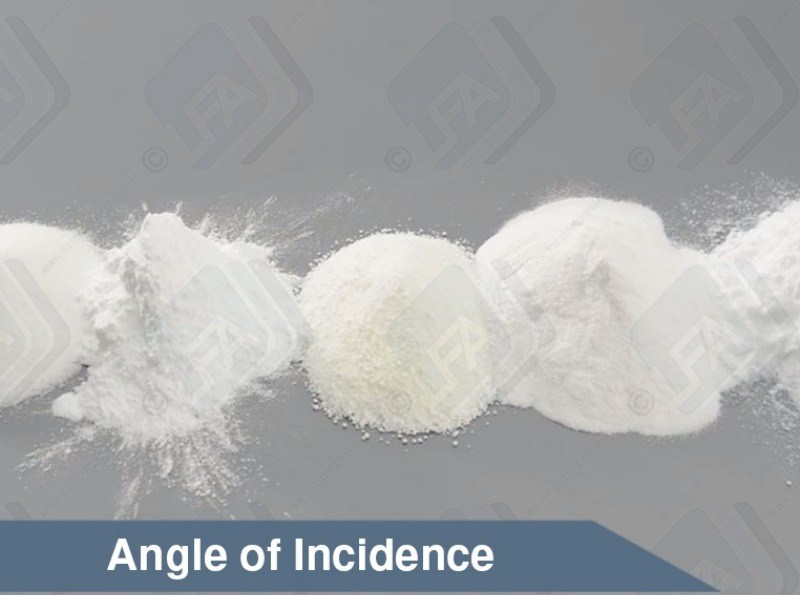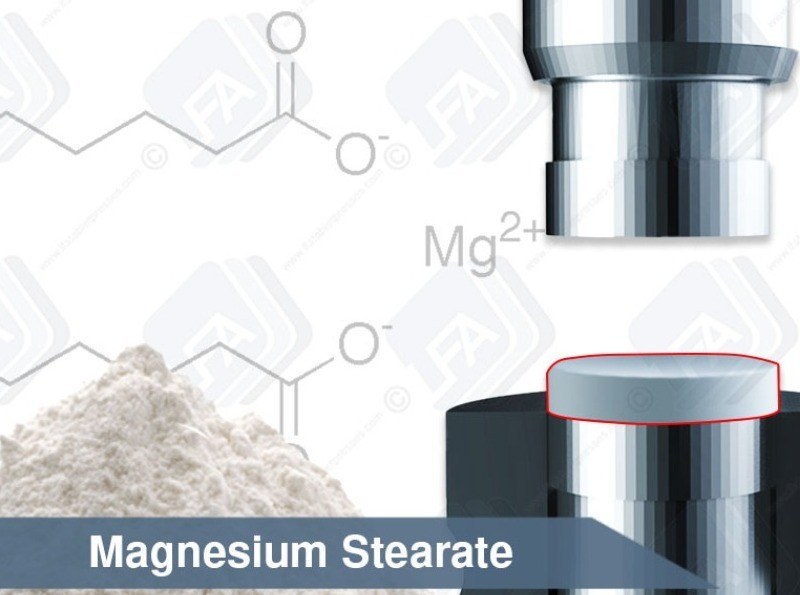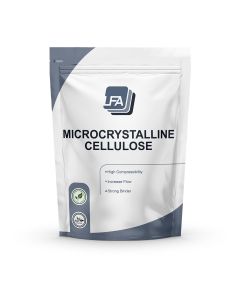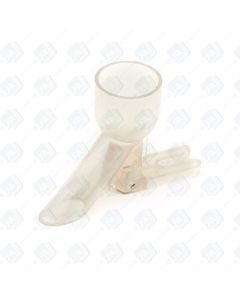Le stéarate de magnésium est une fine poudre blanche. Sa fonction principale est de fournir un lubrifiant pour gélules et comprimés. Il augmente la fluidité, qui assure une efficacité durant le processus de fabrication.
Le stéarate de magnésium est un des agents fluidifiants les plus populaires dans l’industrie. Il est populaire grâce à son efficacité en tant que lubrifiant sec. Il est inerte et peut rendre votre processus de formulation beaucoup plus simple.
Le stéarate de magnésium est un sel de magnésium qui a aussi de l’acide stéarique. L’acide stéarique est un gras saturé de 18 atomes de carbone de long qui est souvent trouvé dans l’alimentation. Des stéarates représentent une partie naturelle de tout type de gras d’origine animale à végétale. C’est un acide gras commun qui peut être trouvé dans les poissons, céréales, œufs, beurre, volailles, viandes et produits laitiers. Dans la viande, il représente un tiers du gras saturé. Cela est important pour la familiarité des consommateurs. Il illustre également l’aspect sans risque de cet ingrédient. Ce n’est pas quelque chose de nouveau pour le corps humain. Il ajoute un élément de sécurité à votre produit.
Pourquoi utiliser des lubrifiants?
Les lubrifiants sont cruciaux dans la fabrication de comprimés. C’est la raison pour laquelle le stéarate de magnésium est si communément utilisé. Le but d’un lubrifiant est d’améliorer des avantages spécifiques de traitement. Il existe trois rôles importants pour un lubrifiant :
Réduire la friction à la jonction entre une surface de comprimés et le mur de matrice durant l’éjection. Cela réduira l’usure sur les comprimés.
Eviter que la solution colle aux pièces d’une machine qui est actuellement en fonctionnement.
Améliorer la fluidité en réduisant la friction parmi les particules avec elles-mêmes.
Un excellent lubrifiant formera une couche résistante sur la surface. Un autre facteur avantageux est qu’il est défavorable à un changement des variables du processus. Des variables du processus sont une partie dynamique du processus qui peut changer d’une manière donnée. Cela sera généralement une pression de fluide et une température. Si un de ces changements intervient, cela ne devrait pas affecter le processus de fabrication.
Le magnésium est une partie importante de la santé. En tant que minéral essentiel, il est souvent absent du régime alimentaire humain en dépit des nombreux endroits où il peut être trouvé. Il aide à garder une glycémie et une pression sanguine à des niveaux adéquates. Il aide à former l’ADN et la protéine et maintient le bon fonctionnement des muscles et des nerfs. Les femmes ont besoin de 320 milligrammes par jour alors que les hommes ont besoin de 420 milligrammes par jour pour une excellente santé.
Le stéarate de magnésium est :
Listé comme GRAS (généralement considéré comme sans danger)
Conçu comme un additif alimentaire en Europe
Fabriqué à partir d’huiles végétales, plus communément l’huile de palme et huile de coton
Manipuler stéarate de magnésium
Les Stéarates peuvent être fabriqués au travers de l'hydrogénation (traitement par hydrogène). Le résultat de ce processus est un produit qui doit être manipuler correctement.
Le stéarate de magnésium ne peut pas être mélangé avec l’air car une explosion de poussière peut avoir lieu. Il doit être gardé à l’écart des flammes à tout prix. Si il est sec, il peut être chargé électrostatiquement en tourbillonnant et versant parmi d’autres actions. Si inhalé, il peut causer une toux et si ingéré, des vomissements peuvent se produire. Utilisez des gants protecteurs, des lunettes de protection et un masque lors de la manipulation de ce produit.
La formule chimique du stéarate de magnésium est Mg(C18H35O2). D’autres noms pour le stéarate de magnésium sont acide octadécanoïque et sel de magnésium.
Ce produit est généralement le premier choix pour un lubrifiant sec. De plus, en tant que minéral confortable dans le corps humain, il peut être consommé sans danger de manière régulière. C’est peut-être l’excipient parfait pour votre produit.
Rédigez votre propre commentaire
Are all excipients safe for all ages to consume?
Yes, it does not matter what age, size or sex the person consuming the products is. It is, however, important to check the intolerance data.
Are all the excipients safe for human consumption?
Yes, all of the excipients are safe for human or animal consumption. There are some precautions that should be taken when handling them and there are some people that might have intolerances to some of them. Information on this can be found in the products MSDS and Intolerance Data Sheet. This can be found in this section for every excipient.
Sont votre Excipients naturels?
Oui, tous nos Excipients sont extraits de sources naturelles. Pour plus d'informations, veuillez visiter les pages produits.
Can I get a better price for excipients than is listed on the website?
Yes, we have bulk pricing for all of our excipients, and these can be found in this section. We offer bulk in 500 kg, 1 ton, 2 ton and 5 ton lots. The prices are set on these quantities as these are the amounts that will fit on pallets.
Can I have a CoA for my Excipient?
Yes. CoA stands for Certificate of Analysis this is also known some times as an MSDS (Material Safety Data Sheet) all of the information contained in a CoA is inside the MSDS for every LFA product which is emailed to you after purchase.
Puis-je produire des comprimés sans Excipients?
Il est peu probable que vous serez en mesure de produire des comprimés sans l'aide des Excipients à tous. Certains produits ne se lient sans Excipients, mais alors ne pas s'écouler à travers la machine. Nous vous conseillons d'utiliser un
Dissolving rate? Any known factors that can affect the rate, speed up or slow down the breakdown of a tablet?
Yes. There are two things at play here. You can get hygroscopic and hydrophobic excipients. Hygroscopic means that they take on water quickly, while hydrophobic means that they repel water.
There are products know as supper disintegrants. These products help the breakdown of tablets. At the moment LFA does not sell any supper disintegrants.
Magnesium stearate is hydrophobic this means that it will slow the breakdown of a tablet.
However, it is used in such small amounts that most of the time it will not make a difference to our customer's products. If they would like to be sure then they should conduct what is known as a disintegration test.
How long is the storage period of each excipient? What is the shelf life?
Firmapress - 2 years form batch date.
Dextrose - 3 years from batch date.
Dicalcium Phosphate - 3 years from batch date.
Microcrystalline Cellulose -
Magnesium stearate -
Lactose - 2 years from batch date.
Silica Dioxide - 2 years from batch date.
How should I clean contact parts that have come into contact with my excipients or active ingredients?
here are 6 steps that should be followed as a general rule of thumb when cleaning contact surfaces that have come into contact with powders:
Dry Clean - First you need to remove as much of the dry powder as possible. You can do this using a hover/vacuum. Make sure that the vacuum you are using has a filter good enough to handle fine dust.
Wet Clean - Next you need to perform a wet clean. This can be done with warm water and soap or if available an ultrasonic cleaner.
Rinse - Next you need to rinse off any soap with potable water (drinking water). You do not have to do this if you used an ultrasonic cleaner in the last step. It is important to ensure that all parts are thoroughly dried immediately after washing to avoid any rusting.
Sanitise - Next you need to sanitise the surface. This step is recommended by the FDA. There are a number of sanitising solutions available designed to be applied and left on.
Lubricate - You now need to lubricate any parts that require it. This should be with the appropriate grade oil or grease considering your use and greasing chart. Store - Finally store any of the parts in a cool dry place. If you are storing them on the machine then make sure the machine is in a temperature controlled environment with low humidity.
Quelle est la différence entre la gamme des excipients?
Nous vous proposons de la Cellulose Microcristalline, Stéarate de Magnésium, le Phosphate Dicalcique et Firmapress dans notre gamme des excipients.
La Cellulose microcristalline est un agent de liaison, qui renferme le contenu de la tablette.
Le Phosphate dicalcique est un écoulement de l'agent et contribue à déplacer les ingrédients dans la machine avant qu'ils sont compressés.
Le Stéarate de magnésium est un lubrifiant sec et aide à nouveau avec le mouvement des ingrédients dans la machine, mais contribue également à l'éjection de la tablette de la machine. Veuillez noter que le Magnésium Sterate ne se lie pas par lui-même.
Firmapress est un tout en un mélange de Cellulose Microcristalline, Stéarate de Magnésium et Phosphate Dicalcique.
What is the mesh size of your excipients? etc.
Dextrose - approx 100 mesh
Dicalcium Phosphate - approx 100 mesh
Microcrystoline Cellulose - approx 120-200
Magnesium sterate -
Lactose - 80 mesh
Silica Dioxide -
Firmapress - 100-200 mesh
What kind of agent is each excipient?/ What is the main use of each excipient?
Dextrose - Sweetener, binding agent, good for chewable tablets or candy.
Microcrystalline Cellulose - Binder, filling agent. Good at binding tablets and making them bigger. It can also be used as a filler for capsules.
Magnesium stearate - Dry Lubricant. This stops products from getting stuck to the tooling. It can also help with powder flow issues and caking issues.
Lactose - Binder, sweetener and bulking agent. It has a large mesh so it flows well but most people do not like it because of the intolerance issues.
Silica Dioxide - Flowing agent. This assist powders in flowing smoothly through the machines. It also helps with cacking issues where powders get stuck to the machine.
What kind of condition should excipients be stored in?
Firmapress - 2 years form batch date.
Dextrose - 3 years from batch date.
Dicalcium Phosphate - 3 years from batch date.
Microcrystalline Cellulose -
Magnesium stearate -
Lactose - 2 years from batch date.
Silica Dioxide - 2 years from batch date.
Which excipient should I add if the product doesn't bind well?
If your product does not bind well then we would recommend using MCC. This can be used in any % the limiting factor is the size of the tablet.
If the amount of MCC you would have to use would be too much or if you do not want to use MCC then you have 3 other options: Ask your supplier for a directly compressible or tabletable grade of your product. Spray dry your product. Wet granulate your product.
Which excipient should I add if the product is sticky?
If your product is sticky then you will need to add a dry lubricant to your mix. For this, we recommend magnesium stearate.
We do not recommend that you add more than 1% to the mix as more than this can cause capping. If your product is still sticky at this point then we would recommend looking into granulation.
Which excipient should I add if the product/API is clumpy?
If your product or API is clumpy then you will need to add an anticaking agent. For this, we recommend silicon dioxide. We only recommend adding a maximum of 2% of this to the mix









